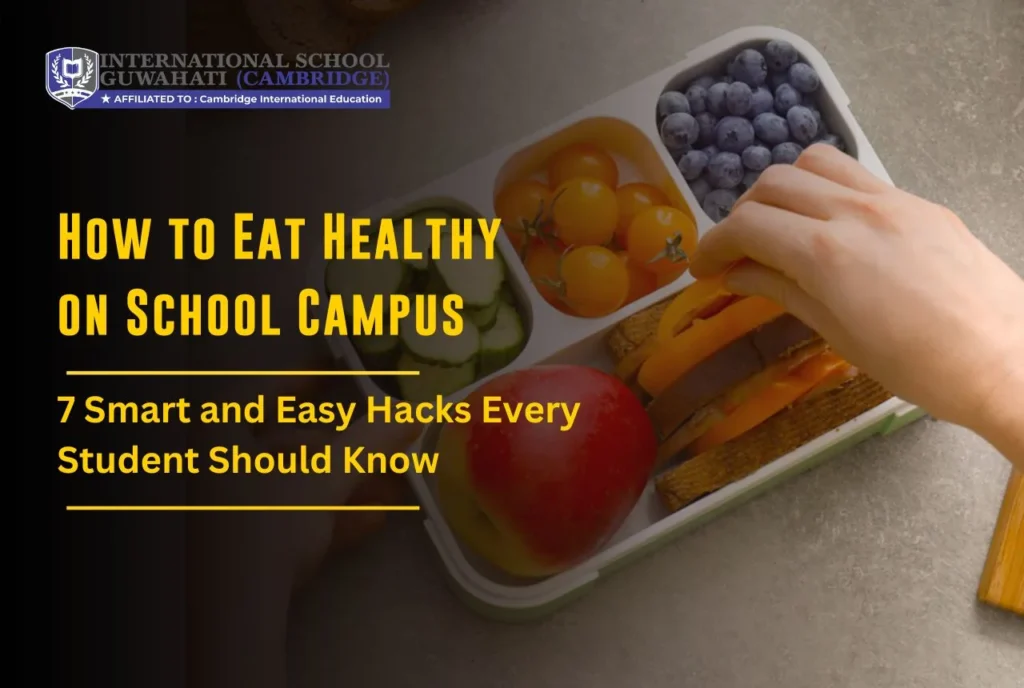![]()
Learning how to eat healthy on school campus is essential for every student striving for academic success and personal well-being. With packed schedules, limited healthy food choices, and social pressures, students often fall into unhealthy eating patterns.
Fast food, sugary snacks, and skipped meals can quickly become the norm. However, healthy eating doesn’t have to be hard. With the right strategies, students can fuel their minds and bodies effectively throughout the school day.
In this blog, we’ll explore practical, enjoyable tips that make it easier to choose nutritious foods—even in a busy campus environment.
How to Eat Healthy on School Campus: The Essentials
The question of how to eat healthy on school campus matters more than ever in today’s fast-paced academic world. A balanced diet fuels your brain, supports immunity, improves mood, and enhances academic performance. Yet, students face several hurdles—from fast food temptations and dining hall indulgences to budget issues and limited prep time.
Unhealthy choices often sneak in due to peer influence or the convenience of vending machines. Lack of planning and awareness can lead to skipped meals or poor nutritional intake. Over time, this affects energy levels, concentration, and even long-term health.
That’s where schools play a vital role. For instance, Cambridge International School Guwahati is a leading example in championing student wellness. With a well-curated cafeteria, health education sessions, and access to wholesome meals, the school demonstrates that nutrition and education go hand-in-hand.
By understanding how to eat healthy on school campus and adopting mindful habits, students can overcome everyday dietary challenges. The goal isn’t perfection but progress—choosing better food more often, without stress or guilt.
7 Amazing Hacks to Transform Your Meals on Campus
1. Eat a Nutritious Breakfast Every Day
Breakfast is your academic fuel. Skipping it leads to low energy and reduced concentration. To start the day right, opt for quick and nutritious options like overnight oats, peanut butter toast, yogurt parfaits, or fresh fruits. These choices are rich in fiber, protein, and essential vitamins.
If mornings are hectic, prepare breakfast the night before or keep ready-to-go snacks on hand. With just 5–10 minutes of prep, breakfast can easily become a sustainable habit—even on the busiest mornings.
2. Master the Art of Smart Snacking
Snacking smart is key to avoiding energy crashes. Instead of reaching for chips or sugary treats between classes, keep healthy snacks like almonds, roasted chana, trail mix, or whole-grain crackers in your backpack. These options provide sustained energy and improve focus.
Pre-pack your snacks in reusable containers or small pouches for quick access. This way, you’ll steer clear of vending machines and feel fuller for longer without excess calories.
3. Make Wise Choices in the Dining Hall
Knowing how to eat healthy on school campus means navigating the dining hall wisely. Prioritize grilled over fried options, choose whole grains, and fill half your plate with vegetables. Be mindful of high-calorie dressings and sugary sauces.
Balance is everything—enjoy treats occasionally, but let your main focus be on proteins like eggs, legumes, or lean meats along with fresh salads or steamed veggies. Creating a colorful plate isn’t just Instagram-worthy—it’s brain-friendly too!
4. Stay Hydrated and Choose Healthy Drinks
Hydration plays a crucial role in cognitive function and physical energy. Carry a reusable water bottle and aim to drink water throughout the day. Avoid sugary drinks like sodas or packaged juices that spike blood sugar and contribute to weight gain.
Instead, opt for infused water with lemon, mint, or cucumber, or sip herbal teas. Staying hydrated helps reduce fatigue, improve skin health, and even curb unnecessary cravings.
5. Learn Basic Cooking Skills
Knowing how to prepare simple, healthy meals is a game-changer for students. Learn easy recipes like veggie stir-fries, sandwiches, salads, and wraps that require minimal ingredients and time. These are not only nutritious but also budget-friendly.
Use campus kitchenettes or communal cooking areas if available. With basic tools and a little practice, cooking becomes an empowering skill that lets you control your nutrition.
6. Plan Your Meals and Budget Wisely
Planning your meals helps eliminate last-minute unhealthy food decisions. Set a weekly meal schedule with balanced options and shop with a list to avoid unnecessary spending. Buy in bulk when possible and consider meal-sharing with roommates or friends.
Use leftovers creatively—turn yesterday’s grilled veggies into a wrap or rice bowl. Smart budgeting and planning not only reduce food waste but also ensure you’re eating right without straining your wallet.
7. Use Campus Resources and Support Systems
Many schools offer resources that promote student wellness. From nutrition workshops to dedicated wellness clubs, make the most of what’s available. For instance, Cambridge International School Guwahati offers healthy cafeteria meals, wellness initiatives, and extracurricular programs focused on fitness and mindfulness.
Surrounding yourself with like-minded peers or joining student cooking groups can further motivate you to stay on track. Remember, you’re not alone—seek support and share the journey!
Overcoming Common Challenges: Real-Life Solutions
One of the biggest barriers to how to eat healthy on school campus is peer pressure. Friends might opt for fast food or skip meals, but staying committed to your goals is key. Find balance by occasionally joining in while mostly sticking to your plan.
Another challenge is time. Between classes, homework, and activities, it can be tough to prioritize nutrition. Combat this with meal prepping on weekends and packing portable meals like wraps, fruit, or homemade trail mix.
Staying consistent requires motivation. Keep visual reminders, set small weekly goals, or reward yourself for healthy habits. When healthy eating feels like a lifestyle rather than a chore, it becomes easier to sustain long-term.
Conclusion: Start Your Healthy Eating Journey Today
Now that you know how to eat healthy on school campus, take the first step with these 7 easy hacks. Whether it’s packing a smart snack or mastering meal prep, every action counts.
With consistency and support, you’ll enjoy better health, sharper focus, and a more fulfilling student life.










